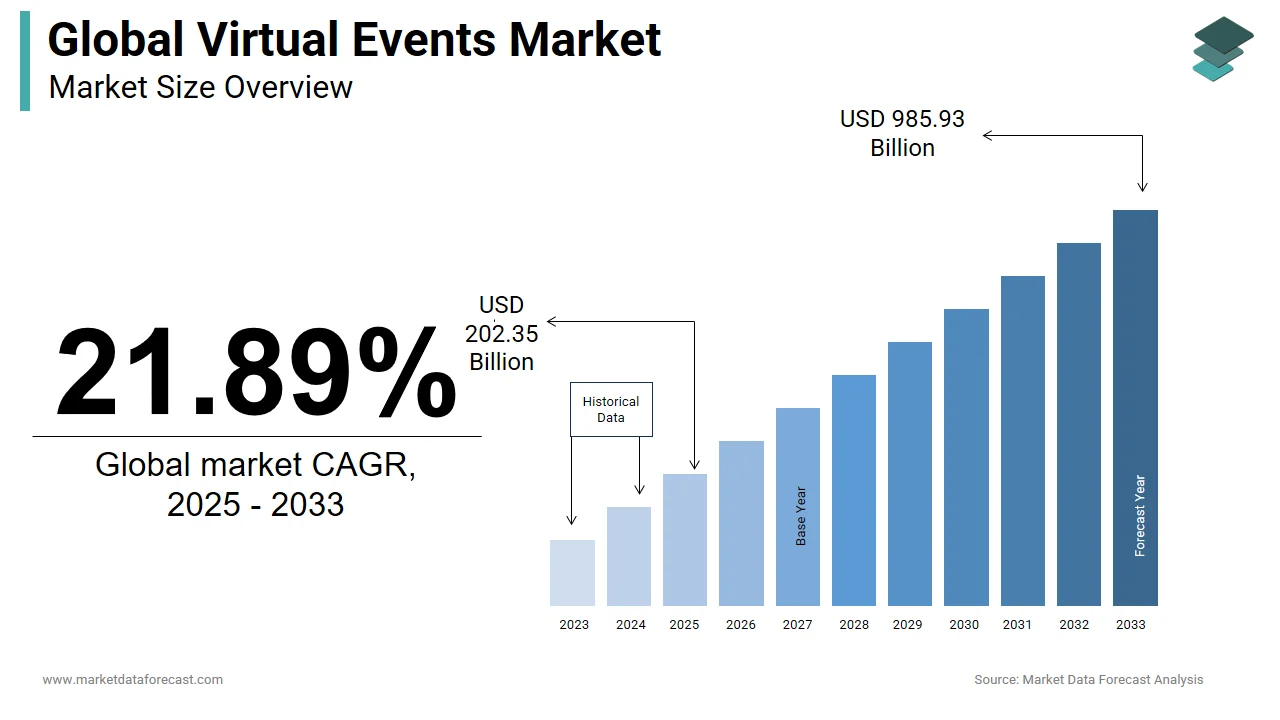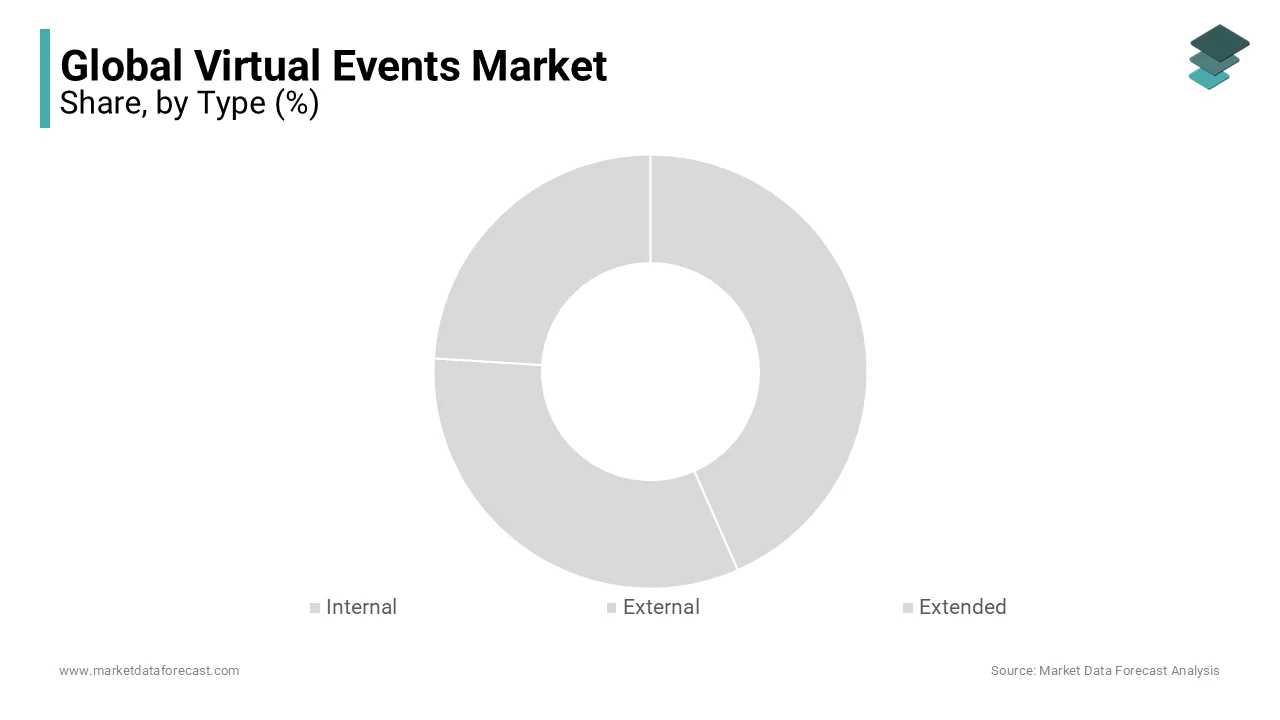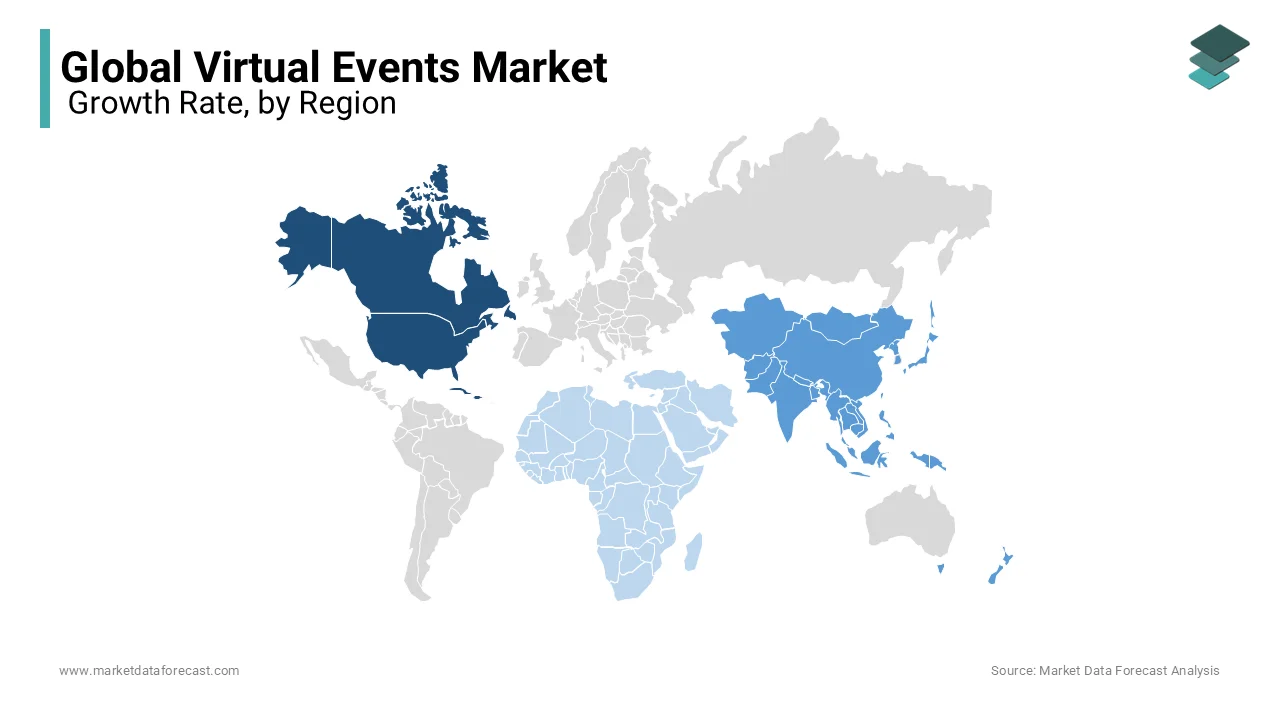Global Virtual Events Market Size, Share, Trends, & Growth Forecast Report – Segmented By Type (Internal, External and Extended), Service (Communication, Recruitment, Sales & Marketing, and Training), Application (Conferences, Exhibitions/Trade Shows, Summits and Others) & Region - Industry Forecast From 2024 to 2032
Global Virtual Events Market Size (2024 to 2032)
The global virtual events market was valued at USD 136.20 billion in 2023. The global market is predicted at USD 166.01 billion in 2024 and estimated to grow at a CAGR of 21.89% to USD 808.87 billion by 2032, during the forecast period.

A virtual event is a web-based event in which people participate in a digital space using their smartphones, laptops, desktop computers, and tablets. Breakout sessions, video and web conferencing, virtual collaboration, and social networking are all included. The participants are not physically present at one location in this type of setup but are connected in a common environment via the internet. Virtual events, as opposed to traditional conferencing systems, provide a more personalised experience, are more cost-effective, and expand an organization's audience reach.
MARKET DRIVERS
The market's upsurge can be ascribed to the fact that virtual events are incredibly cost-effective. The cost-effectiveness allows a big number of people from all over the world to attend a purposeful meeting.
As a result of their time efficiency, the popularity of digitally simulated gatherings among event organisers and attendees is expected to grow during the projected period. Furthermore, virtual events assist firms in lowering the entire cost of hosting a physical seminar, conference, or meeting by allowing planners to save money on the venue, staff, food, participant lodging, and transport. As a result, organisations of all sizes are choosing virtual events over physical events since they are easier to plan, less expensive, and bring the right people to events. As a result, the aforementioned factors are the primary driving drivers behind the virtual events industry.
MARKET RESTRAINTS
A virtual event is highly reliant on the quality of applicable technology. A terrible user experience (UX) event app or website, a broken camera, or a weak internet connection can all spoil the virtual event experience. These reasons may cause virtual events to fail, limiting the development of the virtual events industry.
REPORT COVERAGE
|
REPORT METRIC |
DETAILS |
|
Market Size Available |
2023 to 2032 |
|
Base Year |
2023 |
|
Forecast Period |
2024 to 2032 |
|
CAGR |
21.89% |
|
Segments Covered |
By Type, Service, Application, and Region |
|
Various Analyses Covered |
Global, Regional & Country Level Analysis, Segment-Level Analysis, DROC, PESTLE Analysis, Porter’s Five Forces Analysis, Competitive Landscape, Analyst Overview on Investment Opportunities |
|
Regions Covered |
North America, Europe, APAC, Latin America, Middle East & Africa |
|
Market Leaders Profiled |
6Connex (US),Cvent (US),Microsoft (US),vFairs (US),On24 (US),Cisco Systems (US),Alcatel-Lucent (France),Pace Digital (South Africa),TCJ Management (Trinidad & Tobago),Mitel (Canada) and Others. |
SEGMENTAL ANALYSIS
Global Virtual Events Market Analysis By Type

The external event category accounted for over 40.0 per cent of total revenue, and it is expected to continue to dominate the market during the forecast period. This can be ascribed to the increased requirement for firms to communicate with other entities to expand. Many organisations partner with technology companies to enable sophisticated technological advancements and provide high-end services to their customers. The increased demand for digitally simulated tools by businesses to conduct or attend any tradeshow, product launch event, press release, client conference, or other external communication is likely to propel the industry forward. The growing trend of outsourcing makes it necessary for businesses to interact with a remote service provider regularly for meetings, data exchange, and training, fueling the expansion of the external virtual events market.
From 2024 to 2029, the extended events segment is predicted to grow at the quickest rate, with a CAGR of about 25%. This is due to the increasing use of virtually simulated platforms that allow remote audiences to engage in any event or gathering at a faraway location in real-time.
Global Virtual Events Market Analysis By Service
The communication category accounted for the largest market share of nearly 35.0 per cent in 2020, owing to the massive development in digitally simulated meetings that is altering the communication environment. Communication solutions and technologies are utilised for a range of objectives, from small meetings to large commercial events. The usage of online platforms for real-time business conversations, declarations, meetings, and announcements has aided segment expansion.
In addition, the increased use of virtual event solutions in the recruitment of candidates from remote places for the convenience of employers and employees is propelling the recruitment service market forward. Online recruitment allows for more accessibility for both sides while also saving time and money.
The fastest CAGR of over 25% is predicted in the training service category during the forecast period, which can be attributable to the high demand for in-house employee training. Employees may learn and improve regardless of their location thanks to the in-house training centre, which allows for easy access to skill development.
Furthermore, sales and marketing services are expected to increase significantly throughout the forecast period, owing to increased promotional activities carried out by enterprises to preserve market competition. The importance of communication and collaboration solutions in the sales and marketing department has long been recognised, as they help to raise product or service awareness among potential customers, resulting in revenue generation.
Global Virtual Events Market Analysis By Application
The exhibitions/trade shows category had the highest revenue share of nearly 30.0 per cent, and this dominance is likely to continue throughout the projection period. This expansion is due to the growing requirement to do business by displaying or presenting products, evaluating the competition, marketing their product and service offerings, and keeping track of recent industry trends and prospects. Exhibitors choose digital spaces because they may save money on travel, promotional materials, lodging, and other expenses involved with trade shows and exhibitions. Such events attract a large number of guests and quality leads, helping them to network and improve engagement.
The other segment, which includes virtual events such as job fairs, concerts, meetings, webinars, and keynotes, is expected to grow at a CAGR of over 25.0 per cent. Furthermore, the digital summits category accounted for a significant portion of the market and is expected to play a vital role in driving the industry's growth. Digital conferences are formal gatherings or discussion sessions in which a group of people gathers online to debate ideas or problems relating to a certain topic.
The conferences market is predicted to increase rapidly due to the multiple advantages provided by virtual platforms, such as quick scalability and control, easy data collection and measurement of results, global reach, and cheaper prices. As a result of the cancellations and postponements of many in-person events due to the recent coronavirus outbreak, marketing teams have been spotted reallocating marketing budgets to virtual events.
REGIONAL ANALYSIS

North America had the greatest revenue share of over 40.0 per cent in 2020 and is likely to continue to dominate the market during the forecast period. This can be linked to the United States and Canada's technical breakthroughs, stable economies, and advanced networking infrastructure. North America is regarded as a business hub, with a higher rate of new and advanced technology deployment. The increased use of digitally simulated platforms, notably in the healthcare industry, is predicted to propel Canada's economy forward significantly over the forecast period.
From 2024 to 2029, Asia Pacific is predicted to be the fastest-growing market, with a CAGR of around 26 per cent. Due to their large consumer bases, China and Japan gained considerable revenue shares in the area for deploying digital communication systems. Regional growth is predicted to be fueled by the increasing adoption of new technologies, which will be supported by the implementation of a high-speed 5G network. Because of the growing number of SMBs and widespread acceptance of technology in these countries, India and Australia are likely to have a significant growth in market share.
Latin America, the Middle East, and Africa, on the other hand, are predicted to increase significantly from 2024 - 2029, owing to rising disposable income, developing UCaaS applications, and the growing number of start-ups and conglomerates in these countries, among other things. Due to a significant shift in the adoption of virtual platforms for business, Europe is projected to have sluggish growth.
KEY PLAYERS IN THE GLOBAL VIRTUAL EVENTS MARKET
- 6Connex (US)
- Cvent (US)
- Microsoft (US)
- vFairs (US)
- On24 (US)
- Cisco Systems (US)
- Alcatel-Lucent (France)
- Pace Digital (South Africa)
- TCJ Management (Trinidad & Tobago)
- Mitel (Canada)
RECENT HAPPENINGS IN THE GLOBAL VIRTUAL EVENTS MARKET
-
6Connex has agreed to buy Eventory, one of the top global event management platforms, to deliver a greater range of virtual and hybrid event services to its customers. The terms of the acquisition were not disclosed.
-
The announced partnership between Meta, formerly Facebook, and Microsoft will now allow customers to integrate Meta's Workplace corporate social network software with Microsoft Teams.
-
Fairs has released their mobile event app, which is currently available for Apple and Android users. The app will complement their existing immersive virtual and hybrid event platform while also providing benefits to those holding solely in-person events. The app was created to work for any type of event, for any organisation, in any industry.
DETAILED SEGMENTATION OF THE GLOBAL VIRTUAL EVENTS MARKET INCLUDED IN THIS REPORT
This research report on the global virtual events market has been segmented and sub-segmented based on the type, service, application, and region.
By Type
- Internal
- External
- Extended
By Service
- Communication
- Recruitment
- Sales & Marketing
- Training
By Application
- Conferences
- Exhibitions/Trade Shows
- Summits
- Others
By Region
- North America
- Europe
- Asia Pacific
- Latin America
- Middle East and Africa
Frequently Asked Questions
How are virtual events contributing to sustainability efforts globally?
Virtual events significantly reduce the need for physical travel, thereby lowering carbon emissions associated with transportation. Additionally, they minimize the use of resources such as paper and plastic, making them more environmentally friendly compared to traditional in-person events.
What technological innovations are shaping the future of virtual events?
Technological innovations such as augmented reality (AR), virtual reality (VR), and artificial intelligence (AI) are revolutionizing the virtual events landscape. These technologies enhance engagement levels, provide immersive experiences, and enable personalized interactions for attendees.
What security measures are in place to protect sensitive data during virtual events?
Virtual event platforms implement robust security measures such as encryption, secure authentication protocols, and data access controls to safeguard sensitive information. Additionally, regular security audits and compliance with data protection regulations ensure the integrity and confidentiality of attendee data.
How are virtual events bridging the gap between businesses and consumers in remote areas?
Virtual events serve as an effective platform for businesses to connect with consumers in remote areas where physical access may be limited. By leveraging digital technologies, companies can conduct product launches, marketing campaigns, and customer interactions, thereby expanding their reach and market penetration.
Related Reports
Access the study in MULTIPLE FORMATS
Purchase options starting from $ 2500
Didn’t find what you’re looking for?
TALK TO OUR ANALYST TEAM
Need something within your budget?
NO WORRIES! WE GOT YOU COVERED!
Call us on: +1 888 702 9696 (U.S Toll Free)
Write to us: [email protected]